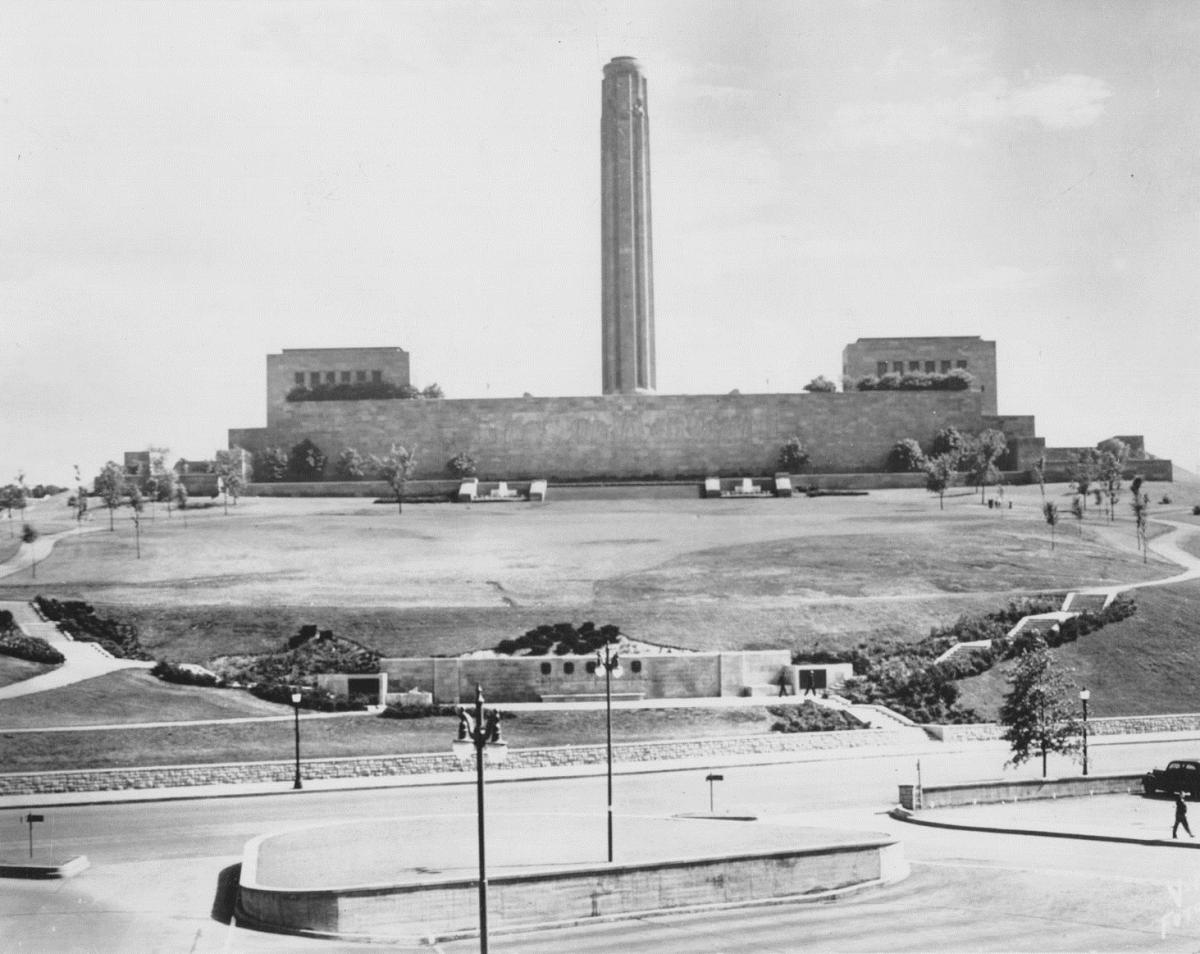Liberty Memorial
The Liberty Memorial, one of Kansas City’s most recognizable landmarks, is the only major memorial and museum in the United States dedicated to World War I.
World War I, also known as the “Great War,” ended November 11, 1918. On November 29th, after an editorial in the Kansas City Journal newspaper suggested a monument memorializing those who served in the [first] World War, Kansas City’s City Council appointed well-known lumber businessman Robert A. Long as chairman of the “Committee of One Hundred.” Composed of civic leaders, citizens active in war projects, and those who had sons and daughters in the service, the committee grew in number to 250 as members met and talked with the public for several months to determine what type of memorial should be built. The slogan for the memorial drive was, “Lest the Ages Forget.” Newspapers contained ballots to garner the public’s thoughts. A smaller committee was then created to be custodian of monies raised and to choose the site; it became known as the Liberty Memorial Association. This committee included Robert A. Long, J. C. Nichols, Frank P. Sebree, and William Volker, among others.

A big parade in Kansas City’s downtown area honoring the Kansas City war dead kicked off an intense drive to raise money for the memorial in late October 1919. People were encouraged to participate in fundraising through their organizations, churches, schools, and neighborhoods. Daily bulletins appeared in the newspapers to show the fund’s progress. Within a week, over two million dollars had been raised.
Several sites for a memorial were considered, including Swope Park, but the site south of Union Station, above what was then Union Station Park and just east of Penn Valley Park, was chosen. The high hill would give the memorial a dominant visibility to all, including the busy traffic going in and out of Union Station and in return, the hill had a lovely view of the city. There were some houses and buildings on parts of the property but the area had not been developed as much as other places in the mid-town area and would require fewer evictions. Some of the land was acquired by condemnation and some was donated. Heading the group working to acquire the property for the memorial was J. C. Nichols, a local real estate businessman. H. F. McElroy, also in real estate, was in charge of negotiating for acquisition of the property. McElroy would become better known later as Kansas City’s City Manager in the controversial years of the 1920s and 1930s.
The design originally proposed included an art gallery, city hall, courthouse, post office, library, and armory but a simpler plan of a memorial, museum, and memorial hall was adopted. There was to be a place to contain war trophies, records of those who served in the war, and an honor roll for those who died, as well as a place for meetings for service people and “patriotic societies.” The memorial design proposed by H. Van Buren Magonigle, a noted New York architect, unanimously won the design competition. The design is of Egyptian Revival style. This style was popular in the 1920s in part due to the archaeological expeditions in Egypt at that time including the discovery of King Tutankamen’s tomb in 1923.
On November 1, 1921, a dedication of the land for the memorial site was held. It was the only time that five Great War leaders appeared together. In attendance at the ceremony were Allied commanders Marshal Ferdinand Foch (France); Admiral David Earl Beatty, Commander of the British Navies; General Armando Vittorio Diaz (Italy); Lt. General Baron Jacques (Belgium); and General John J. Pershing, Commander of the American Expeditionary Forces. These leaders are memorialized on the “Dedication Wall” north of the memorial buildings and courtyard.
In 1924, President Calvin Coolidge attended the ceremony when the cornerstone was laid. Coolidge also presided over the official dedication of the Liberty Memorial on November 11, 1926. More than 100,000 people were at the dedication ceremony, including Queen Marie of Romania and her children. Queen Marie, the daughter of Queen Victoria of England, was a popular international figure because of her Red Cross service during the war and her published writings.
In 1926, the striking and simple structures dedicated included the central tower of 217 feet, the museum building on the west side of the tower, and the “Memory Hall” building on the east, with sphinxes guarding the memorial buildings. All are made of Indiana limestone. On the central tower at the top are carved Guardian Spirits of Honor, Courage, Patriotism, and Sacrifice. Atop the tower is the “Flame of Inspiration.”
Over the years, additions have been made to the memorial property. Beginning in 1932 and in following years, hawthorn and oak trees were planted along the east and west sides of the Liberty Memorial Mall, forming the “Avenue of Trees.” The “Dedication Wall,” designed in 1934 by Edward Prellwitz of the Olmstead Brothers landscape architectural firm in Massachusetts and modified by Kansas City architectural firm Wight & Wight, was added. Kessler Road was built to the west of the memorial and park in 1934. In 1935, Edmund Amateis carved the Great Frieze on the north wall below the tower and main buildings. The Frieze illustrates various stages of war and the celebration of peace; fountains were added near the Frieze. Men of the 89th Division, most of them from Missouri, placed a memorial flagpole at the south entrance in 1948. From 1949 until 1972 Kansas City artist, Daniel MacMorris painted war-related murals in Memory Hall.
Many ceremonies, services, meetings, and city events have occurred at the Memorial over the years, including a rededication in November 1961, attended by former Presidents Harry S. Truman and Dwight D. Eisenhower. The site reopened in 2006 as the home of the National World War I Museum.
A version of this article previously appeared at http://www.kchistory.org/content/liberty-memorial-profile
This work is licensed under a Creative Commons Attribution-NonCommercial-NoDerivatives 4.0 International License.
